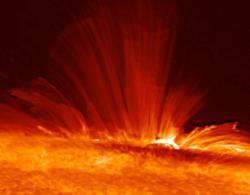Cosmologists from around the world will meet at Imperial College London next week to challenge the theories behind the 'standard model' used to understand the universe. Speakers at the four-day conference, jointly organised by Imperial and the University of Alabama in Huntsville, and sponsored by the U.S. National Science Foundation, will cover a wide range of unanswered questions on how the universe was formed and what has been happening to it after formation.
The 'Standard Cosmological Model' is the prevailing scientific theory used to explain how the universe began with the Big Bang, how it has evolved since, and how the known atoms and molecules of everyday life, along with the postulated unknowns of the universe - dark matter and dark energy - interact with each other. Speakers at Imperial's Outstanding Questions for the Standard Cosmological Model conference will present an overview of evidence for and against this model, and will look at how to probe questions that it leaves unaddressed.
For all of his death-defying stunts, Harry Houdini could not escape the Grim Reaper: the unparalleled performer, age 52, died on Halloween 1926, taking with him many of his trade secrets. The rumors that he was murdered, however, soon took on a life of their own.
Eighty-one years later, Houdini's great-nephew wants to exhume the escape artist's body to determine if he was poisoned by enemies for debunking their bogus claims of contact with the dead. A team of top-level forensic investigators would conduct new tests once Houdini's body was disinterred, the legendary star's relative told The Associated Press.
"It needs to be looked at," said George Hardeen, whose grandfather was Houdini's brother, Theodore. "His death shocked the entire nation, if not the world. Now, maybe it's time to take a second look."
Lisa Zyga
PhysorgThu, 22 Mar 2007 20:41 UTC
Using a novel quantum computing algorithm, scientists have simplified the process for finding extreme values in a database compared with classical and earlier quantum computing methods. With its reduced time and minimal error probability, this quantum process could significantly increase the speed of computing in global and mobile networks.
Sándor Imre, an engineer at the Budapest University of Technology, calls this new computing process "quantum existence testing," which is a special case of quantum counting. The quantum existence testing algorithm searches unsorted databases to find extreme values, attesting to the intriguing powers of the quantum mechanical effects of parallel processing.
The restless bubbling and frothing of the Sun's chaotic surface is astonishing astronomers who have been treated to detailed new images from a Japanese space telescope called Hinode.

|
| ©JAXA/NASA
|
| Charged particles follow magnetic field lines that rise vertically from a sunspot - an area of strong magnetic field. On the edges of the sunspot, the magnetic field lines bend over to connect to regions of the opposite polarity.
|
Giles Tremlett
GuardianThu, 22 Mar 2007 11:24 UTC
When James Cook thought he had discovered Australia and claimed it for the crown in the 18th century, he was late to the party. Another English explorer had been decades ahead in sighting the great southern land, while Dutch explorers had been charting the continent even earlier.
But evidence has emerged to suggest that neither the English nor Dutch were the first Europeans to reach the continent during the great era of epic sea adventure and global circumnavigation.
Alok Jha
GuardianThu, 22 Mar 2007 11:16 UTC
In almost 20 years of research, it has been the home of some of the most daring ideas to aid exploration: space elevators, crops that could grow on Mars and a shield to protect our planet from global warming. But now Nasa's Institute for Advanced Concepts (Niac) has fallen victim to a very down-to-earth problem - a lack of money.
The US space agency is set to close its futuristic ideas factory as part of a cost-cutting exercise which it hopes will help pay for ambitious plans to explore the moon and Mars. Bobby Mitchell, who works at Niac's headquarters in Atlanta, told the Guardian: "From what I understand, Nasa are out of money. We haven't got an official notice yet but we have heard from Nasa that they are going to discontinue funding."
NASAMon, 19 Mar 2007 15:27 UTC
Scientists have traditionally relied upon indirect data gathering methods to study climate in the Earth's past, such as drilling ice cores in Greenland and Antarctica. Such samples of accumulated snow and ice drilled from deep within ice sheets or glaciers contain trapped air bubbles whose composition can provide a picture of past climate conditions. Now, however, a group of NASA and university scientists has found a convincing link between long-term solar and climate variability in a unique and unexpected source: directly measured ancient water level records of the Nile, Earth's longest river.
Work on Brain-Machine Interface (think monkey controlling a joystick with its thoughts) is old news, but a
patent granted earlier this month underscores researchers' confidence that a broader set of military applications is possible: like controlling weapons with your mind.
NASAWed, 21 Mar 2007 13:26 UTC
It's official: Solar minimum has arrived. Sunspots have all but vanished. Solar flares are nonexistent. The sun is utterly quiet.
Like the quiet before a storm.
This week researchers announced that a storm is coming--the most intense solar maximum in fifty years.
There's a new comet in the southern hemisphere: Comet Lovejoy (C/2007 E2). Terry Lovejoy of Australia discovered it on March 15th using, remarkably, not a telescope but only an off-the-shelf digital camera. The green comet is too dim to see with the naked eye, but it is a nice target for backyard telescopes. After five days of monitoring, the comet's orbit is now known with some accuracy and it is possible to make predictions about Comet Lovejoy's future movements and brightness.
Details.